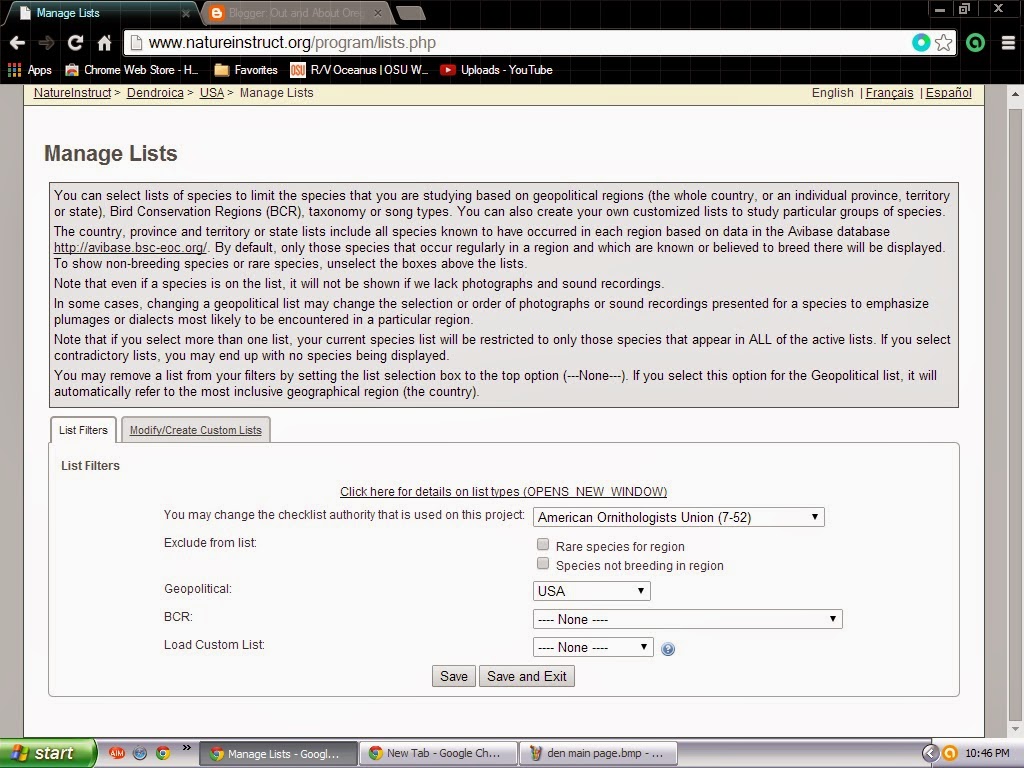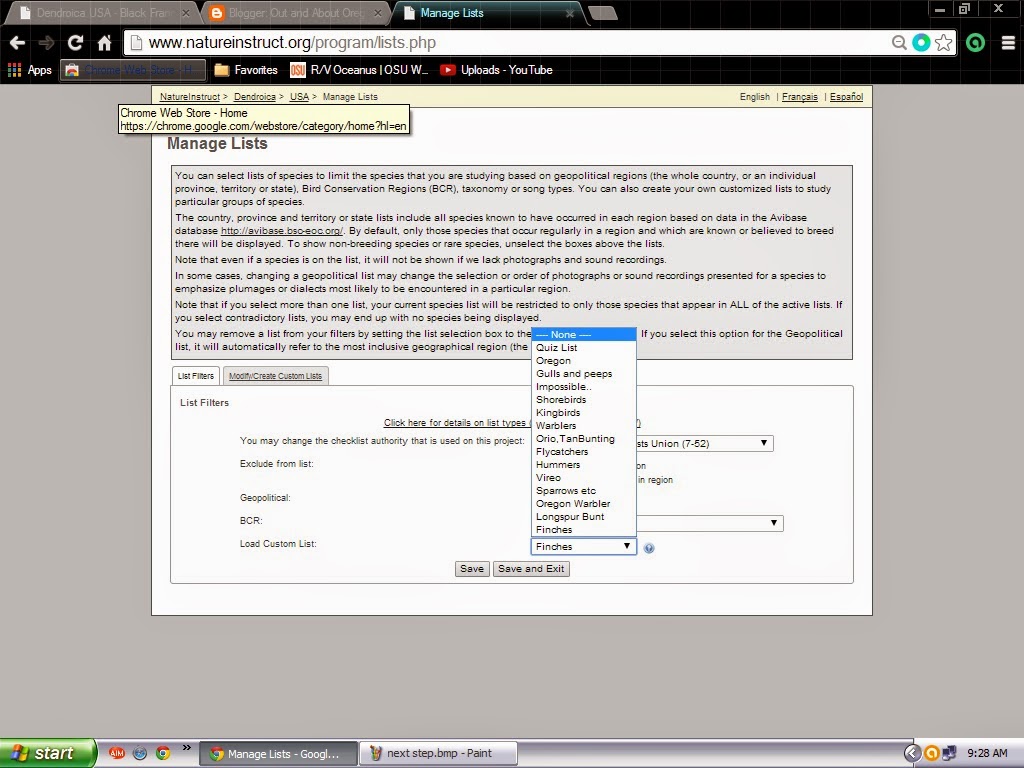A few weeks ago I decided to put this blog together, on the tabs above I selected some of my favorite sites for birding information in Oregon. A few of them concern ocean and weather conditions but I also have one for Dendroica. I have had a few people ask about this site. Dendroica is an inter-active web page that helps professionals, volunteer surveyors and others become familiar with birds in the Western Hemisphere. The USGS, Environment Canada and others are involved in the site. It has many very cool features and is free. I also use Larkwire, both are good for their own reasons. For fine tuning my birding ear, when not in the field, I use Dendroica.
I thought I would post a few screen shots to show how I have used the site over the years. Once you have signed in you get this page. Select the USA.
Once you select the USA, you will get to a page that lists all the birds on the AOU list. This one opened to a Canada Warbler. There are a few features I would like to point out (see below). The print on these shots is hard to read, but next to sounds on the bottom you will see 24 tabs. On this site they have 24 recordings for this species. There will be calls and chip notes. Some of the rarer USA species, like Pallas's Bunting , may have only a few songs. You will also see they have 17 photos. I rarely look at the photos. The cool thing is the tab at lower left, "View Spectrograms". Here the photo will be replaced with a live spectrogram of the bird that is singing or chipping.
Here is a screen shot for the Canada Warbler (see below) after I hit the spectrogram button.
Dendroica does a good job with their written descriptions of the song. It is best to come up with your own written version so you can remember the way you separate out the songs. Their description is in the gray box where they list the source of the recording.
Using a website that lists every bird seen in North America would be a bit complicated, there are features on Dendroica that get this site to work for you and where you live.
Where Dendroica really becomes powerful is when you click on the Manage Lists tab in upper left. It is to the right of the "Lists" tab that in this case shows I am on the US list. Here is how it looks on the Mange List tab (see below).
You can create custom lists for whatever group of birds you want. Creat an "Oregon Woods" list. Create an "Oregon Shorebird Flats" list. Or pick all the expected species you will hear on Mt Tabor and create that list. To start, hit the "Modify/Create Custom List" tab. It will take you here (see below).
In the example below, I decided to create a list for "Finches" and other similar birds. The idea is to select birds from the master list in the box on right and move them over to your own list in the box on left. Please note when you move the bird it will vanish from master list. In the past, I have moved a bird over then forgot that it was already on my list. When I did this I was wondering why Lesser Goldfinch was not on the master list, then I realized I already had moved it to my list.
Once you are done with your list, hit the "Submit" tab next to the list name (see above). Then hit "Back to List Filters" (see above). When you are back to the "List Filters" tab (see below), load in your custom list "Finches".
Your screen will now look like this (see below). Please note all the birds in your "Finch" list are now listed in the box at right. Also you can see the photos or the spectrograms. Please note not all birds will have a spectrogram.
Now take a look at the "Quiz" tab on the upper right. Hit that tab and Dendroica will randomly play songs and chip notes from your list. You highlight the bird you think it is and hit "select". Dendroica will keep tabs on how well you do. You get a point if you pick correctly the first time, but you can keep on selecting until you get it right. I should add the picture goes blank when you take a quiz. There will be a tab on lower right to add the picture back in. Best to use the quiz without the picture.
Below is a screen shot for my custom lists. My "Impossible " list contains things like Red-eyed vs Philadelphia Vireo, I threw in Palm Warbler v Swamp Sparrow v Orange-crowned v Dark-eyed Junco v Pine Warbler. Things like that. As I get them under my thumb, I take them off the list. My "Quiz List " consists of birds I have mastered on "Larkwire".
My final point will be my way of looking at bird songs and sounds. The best way to find birds is to learn their sounds. I have had many birders express to me how hard it is to learn the songs and sounds. I have no musical ear and will quickly forget a tune right after it stops. But I can learn these bird songs. They way I look at it is to group them into similar tunes. For example, consider a classic rock song, say "Alll Along the Watchtower". Bob Dylan wrote it and sings it, but great versions are also out there by Crazy Horse and Jimi Hendrix. They all play the EXACT song, yet I have no trouble deciding if I am hearing Bob, Neil or Jimi playing the tune. Birds are the same way. Purple Finch, Cassin's Finch. House FInch, even Warbling Vireo play the exact same song. But if you get the style down, you can id them.
To carry the point on more, once you know the bird's style you do not need to know all their tunes. I think I can recognize the huge chords of a Beethoven piece or the sound of a Stones song without knowing their full range of tunes. Hermit Warbler and Townsend's Warbler come to mind as well as Yellow Warbler.
For a nice break, here is a great version of this song (If anyone can tell me why I cannot get a video to be posted right on this blog, please let me know). I can load it in but it does not play. (Thanks for the tips Jen, I pasted the html code directly into the blog under the html tab and it worked)
Anyway back to blogging, no question who is singing! Crank it up while you set up your Dendroica site :)
Back to birds..
The best way to learn songs and chips is to do it in the field. But that only works for the birds you see all the time. A bird I use Dendroica for is the Virginia's Warbler. Its song and chip are very similar to Nashville, amongst other birds. This time of year I brush up on my spring songs so I am ready for Malheur. Below is a spectrogram of a Nashville and Virginia's song. You can see how similar they are. Each bird can sing many variations of their song, so it is not always easy.
So there you go. Hope this encourages you to try the site. It is a good one.












This is great, I will definitely be checking it out. I really like the quiz aspect especially. When I get frustrated learning bird sounds I remind myself that I can still identify at least a hundred different dogs by bark alone, so it's just a matter of practice.
ReplyDeleteAs for posting the video- since it's a youtube video you should be able to click on "Share" and then "Embed" and then copy and paste the link they provide directly into your blog post. Hope that helps.
I fixed it! I added a note up in the blog. Kind of cool!
Delete